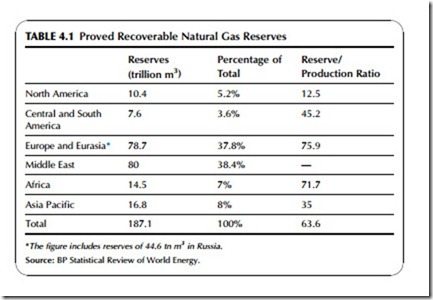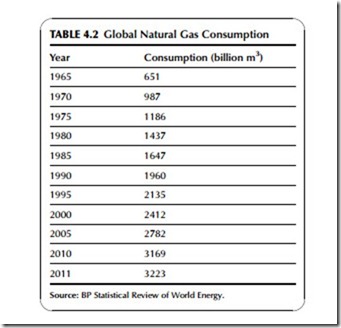NATURAL GAS
While gas turbines are capable of burning a range of fuels, including distillate fuel oil, hydrogen, and gases produced by gasification of both coal and biomass, the main fuel for which the majority of gas turbine power plants are built is natural gas. Natural gas as it is extracted from gas fields is a mixture of combustible hydrocarbons. The main component is methane (CH4), which normally accounts for 70–90% of the total.2 Other hydrocarbons such as ethane, propane, and butane can account for up to 20% of the mixture and there may be up to 8% carbon dioxide, small amounts of oxygen and nitrogen, and up to 5% hydrogen sulfide. The gas is normally cleaned after it has been pumped from the ground to remove impurities such as hydrogen sulfide (this can be processed into pure sulfur), carbon dioxide, and water. The higher hydrocarbons, such as propane and butane, may also be removed for industrial use and the cleaned gas, now referred to as dry natural gas,3 is ready for use.
Natural gas is found in many parts of the world but most countries have only small reserves. Regionally, the Middle East has the largest total proven recoverable reserves at 80 trillion m3 or 38.4% of the global total in 2011, as shown in Table 4.1. The other major reserves are in Europe and Eurasia with
78.7 trillion m3 or 37.8% of the global total. Note, however, that these reserves are dominated by Russian gas, which accounts for 21.4% of the global total. Aside from these two regions, the others in Table 4.1 each hold less than 10% of global reserves.
When broken down by country, four nations hold the bulk of global reserves. The Russian Federation on its own has 44.6 trillion m3 of proven reserves, 21.4% of the total, and Turkmenistan has 24.3 trillion m3, 11.7% of the total. In the Middle East, Iran holds a further 33.1 trillion m3 (15.9%) and Qatar 25 trillion m3 (12%). Among them these four command 61% of proven global natural gas reserves. Other nations rich in natural gas include the United States with 8.5 trillion m3, Venezuela with 5.5 trillion m3, Saudi Arabia with 8.2 tril- lion m3, and the United Arab Emirates, Kuwait, Algeria, Nigeria, and Australia.
Natural gas consumption has been rising steadily over the past four decades (Table 4.2). From 651 billion m3 in 1965, consumption had reached 1649 billion m3 in 1985 and 2782 billion m3 in 2005. By the end of 2011 global annual consumption was 3223 billion m3. The largest national consumer, by a wide mar- gin, is the United States, which used 690 billion m3 in 2011, followed by the Russian Federation with 427 billion m3.4 China, by comparison, consumed only 131 billion m3.
Natural gas is readily transported by pipeline, so this has become the preferred method where pipeline construction is possible. The United States has
extensive pipeline networks, as does Europe, while pipelines from central Asian countries and Middle East nations rich in the resource are beginning to extend both east and west.
As a consequence, much natural gas is traded internationally through pipe-
lines. However, where pipeline delivery is not possible, transportation in liquefied form is possible. Major gas producers such as Qatar liquefy gas for delivery by ocean-going tankers to many parts of the world. Important users of liquefied natural gas (LNG) include Japan, Taiwan, and, more recently, the United States and United Kingdom. With its new shale gas resources, the United States is expecting to become an exporter of LNG in the near future.
Global natural gas supplies are sufficient for another 63.6 years, overall, as the figure in the final column of Table 4.1 indicates. However, local national supplies in some regions are under much greater stress. Most striking is North America where existing proven reserves will last only another 12.5 years at current rates of consumption.5

